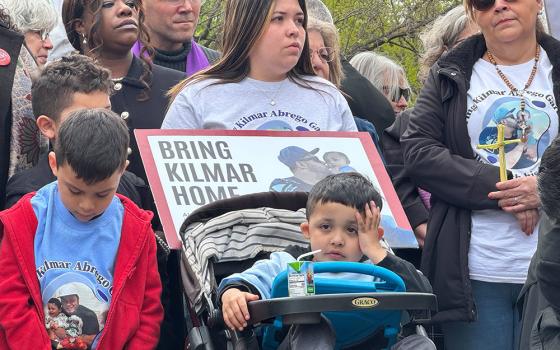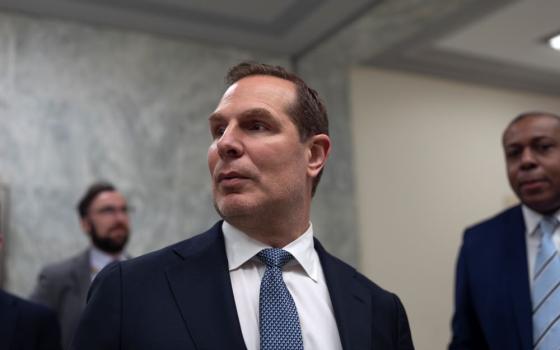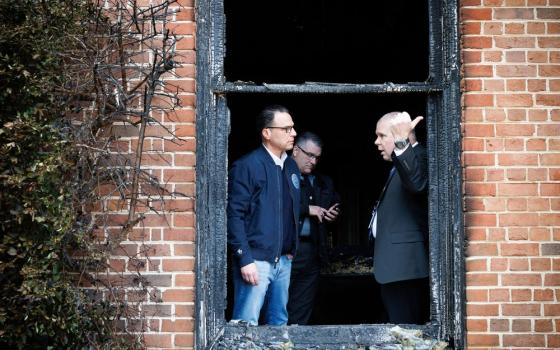
An employee holds the hand of a person at an elderly residence in Brussels April 14, during the COVID-19 pandemic. (CNS/Yves Herman, Reuters)
In March, workers at the senior community St. Therese of New Hope in New Hope, Minnesota, discovered many of their residents had tested positive for COVID-19.
"There was a lot of fear — a lot of fear about working with patients, and about staff bringing it [the virus] home to their families. And then the fear of not having enough PPE [personal protective equipment] around," said Barbara Rode, president and CEO of the facility.
St. Therese became one of the worst hit sites in the country when the pandemic first began spreading in the United States earlier this year. At least 55 residents of the community with a 258-bed nursing home died due to the coronavirus, according to a report in early May by the Star Tribune.
Across the country, nursing homes and elder care centers became high-risk environments, with the virus disproportionately affecting the elderly and immunocompromised. In New Jersey alone more than 6,600 nursing home residents died of COVID-19, while in New York the numbers were more than 6,400. More than 400 nursing homes and long-term care facilities are hotspots for person-to-person transmission, according to Hub, the magazine by Johns Hopkins University.
Independent data collected by the The New York Times shows more than 40% of COVID-19 deaths in the U.S. have been linked to nursing homes. USA Today's data analysis put the percentage at about 40% of deaths.
As virus hotspots move to southern and western states, nursing homes and elder care facilities still remain most vulnerable.
Hit by the first wave
Beginning in January, nursing homes run by dioceses or religious orders began keeping a close watch on the situation, regularly monitoring for signs and symptoms among the residents. But nothing prepared them for the onslaught of infections.
"What we've seen is low-grade temperature and change in cognition as the most common indicator of this virus," said Jeri Reinhardt, vice president of clinical services and performance excellence at Benedictine, a senior care organization based in Duluth, Minnesota, sponsored by the Benedictine Sisters of St. Scholastica Monastery, Duluth.
Benedictine has 32 campuses in Minnesota, Wisconsin, North Dakota, Illinois and Missouri. COVID infections were reported across various sites, with 13 residents and seven associates testing positive at the community in Duluth as recently as July 15.
According to Reinhardt, none of the residents had initially displayed any sudden onset of respiratory distress or other symptoms.
What's common among all nursing homes is the suddenness with which the virus hits, leaving them grappling to contain it.
At Catholic Eldercare in Minneapolis, Minnesota, the nursing and assisted living team found themselves facing a huge challenge due to lack of PPE and masks. "Early on, it was very difficult because of the lack of supplies — testing kits, PPE, etc. So it was very hard to take care of people with COVID, because we had to keep our staff safe," said Maria Barta, director of operations and skilled services.
According to local news reports in April, at least 13 residents had died of the virus at Catholic Eldercare in Minnesota.
In many nursing homes and hospitals in states like California, staff had to wash and reuse masks and PPE due to an acute shortage, reported the Los Angeles Times.
Apart from scarcity of essential supplies, lack of transparency and insufficient infection control precautions contributed to the spread of the virus in nursing homes, reported CNN.
According to Rode, treatment decisions were complicated by "do not resuscitate/do not intubate" wishes dictated by the residents or powers of attorney that were difficult to follow.
"You can't send them to the hospital, because it's their right to decide. You can't intubate. And there are only two things that helps them — intubating or giving them very high oxygen or both. But we had to honor their wishes. And it was hard for the staff to see that," recalled Rode.
To prevent the spread of COVID-19, care facilities began to impose social distancing rules among residents and asked staff to strictly follow CDC guidelines.
Common dining, gathering and entertainment were canceled. Residents were asked to remain in their rooms and family visits suspended.
"The authorities are wanting us to limit the contacts so that we can reduce the infection rate. Because if you open it up to families, you're just going to allow for spread of infection," said Marilyn DuBay, infection control preventionist at Catholic Eldercare.
But with isolation comes concern for the mental well-being of the elderly residents.
"We do Skype calls, residents can go to the window, they can go to a terrace and wave, things like that. But it's not the same thing. Our concern now is they're getting depressed because they can't meet their loved ones. I can't even imagine what that must feel like," said Rode.
Advertisement
Mental health concerns
Recent research conducted by the Bloomberg School of Public Health at Johns Hopkins University in Baltimore found that the number of older Americans experiencing psychological distress doubled during the coronavirus, compared to a study done in 2018.
"We know that isolation leads to depression in everybody, and that older people are really vulnerable to this and it can also lead to dementia," said Carole Cox, professor at the Graduate School of Social Service at Fordham University.
Cox acknowledged that virtual meetings can help to a certain extent, but she wondered if virtual connections can ever replace physical contact.
In March, the Centers for Disease Control and Prevention, or CDC, issued guidance that facilities should restrict visitation of all visitors except for certain compassionate care situations, such as end of life. But many assisted living facilities, out of abundance of caution, restricted even compassionate visits.
"Consequently, people have been left to die alone, while family visits were denied. It's horrible to watch someone dying through the window. I think that's real intergenerational trauma," said Cox.
For those who don't have access to technology or support to connect virtually, the isolation can worsen already fragile physical health, said Cox.
"When they can't go to church or their grocery store, they are stressed out. They don't eat properly. But even this vulnerability is not just related to age, it's related to poverty and race as well," said Cox.
Catholic care facilities have stepped up their pastoral care to help residents cope during this time.
"On our internal channels, we have live streaming of Mass, rosary and other spiritual programs. We have a pastoral team that visits residents based on their needs. They wear protective equipment and visit residents one-on-one instead of in a group setting," said DuBay.
"Our pastoral care staff still go out to residents, but they give Communion in containers. We allow family to visit if residents are in an end of life stage. And we have pastoral care for the families as well," said Rode.
Preparing for the future
Because people with the virus can be asymptomatic, nursing homes are still struggling with infection control.
"We are not out of this yet, so we are constantly preparing for the future, having meeting with health officials regularly and amongst ourselves every day to stay on top of this," said Reinhardt.
Cox of Fordham University said the continued threat to nursing homes could be related to staffing issues.
"The staff often don't have protective gear. They're not necessarily well trained. They are very overworked and underpaid. Some of them might actually be going from nursing home to nursing home, because they have to work several jobs. So that could be why it's still spreading despite the precautions," said Cox.
Nursing homes say they will continue screening staff and residents every day.
"Until there is a breakthrough in medicine that can help mitigate the spread, we will continue to follow CDC guidelines," said Barta of Catholic Eldercare. "We will be making modifications and refinements to keep staff and residents safe. We just have to keep abreast with all new recommendations."
[Sarah Salvadore is a former NCR Bertelsen intern.]







